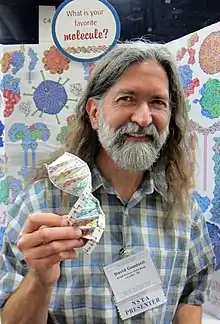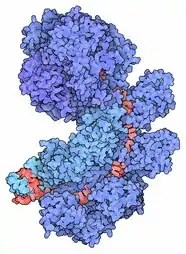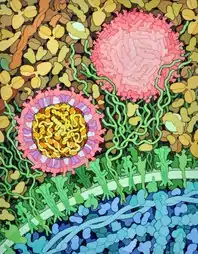David Goodsell
David S. Goodsell, is an associate professor at the Scripps Research Institute[1] and research professor at Rutgers University, New Jersey[2] (joint appointment). He is especially known for his watercolor paintings of cell interiors.[3]
| David Goodsell | |
|---|---|
 | |
| Born | 1961 |
| Alma mater | |
| Occupation |
|
| Website | https://ccsb.scripps.edu/goodsell/ |
| Scientific career | |
| Fields | Structural biology, scientific illustration |
| Institutions |
|
| Doctoral advisor | Richard E. Dickerson |
Education
David Goodsell studied a BSc in biology and chemistry at University of California Irvine.[1] After this, he did a PhD in X-ray crystallography of DNA at the University of California Los Angeles, completed in 1987.[1][4]
Research
Since completing his PhD he as worked as a structural biologist at the Scripps Research Institute (with a 2-year period in University of California in 1992-94).[1] His research topics have included the use of structural biology and molecular dynamic simulations to investigate symmetry in protein oligomers, protein-protein interactions and for computer-aided drug design. In particular he is a developer of AutoDock, the most widely-used program used for molecular docking.[5] His main research focus areas are HIV drug resistance and structure and function of bacterial cells.[6]
Illustration
Goodsell has developed a signature style of scientific drawing. He started painting early in his childhood but did not study art in college.[7] In graduate school, Goodsell became interested in scientific illustration while writing molecular graphics programs to visualize protein and DNA structures.[7]
Goodsell's signature style uses generally very flat shading, with strong and simple colour-schemes.[8] As is typical in medical illustration, the images are simplified representations of the subject that still retain accuracy of the important features.[9][10] His illustrations fall broadly into two categories: individual proteins, and cellular panoramas.
His images of individual proteins are typically computer generated, cell-shaded space-filling representations of proteins, often with cut-aways to show internal binding sites and cofactors. Conversely, his illustration of cell interiors (sometimes called molecular landscapes) are hand-painted in watercolours.[11] They are typically slices through a cell with highly simplified protein structures in a flat style in order to capture overall organisation without overwhelming detail.[12] These cell interiors are often displayed at an effective 1,000,000x magnification for consistency.[13][14] The paintings therefore share a consistent style, aiming to make interpretation easy and as intuitive as possible.[15]
His illustrations are published in the "Molecule of the Month" series by the Protein Data Bank, an archive of protein structures.[7] His illustrations are used as teaching tools,[16] in textbooks, in scientific publications,[9] and as journal cover art.[17]
Process
For individual proteins, Goodsell's illustrations are directly generated from solved protein structures deposited in the PDB using custom computer renderings that he wrote in Fortran (now released as an online illustration tool).[18]
Representations of large macromolecular complexes or crowded cellular environments require interpretation and synthesis of multiple different types of scientific imaging.[19] These include X-ray crystallography and NMR for protein components, cryo electron tomography for larger complexes, and super-res light microscopy and electron microscopy for the cellular environment.[4][20] In these cases, the focus in on portraying the relative scales, orientations and interactions between the components.[9] In order to portray an accurate degree of crowding background gaps are filled with approximate sized generic proteins so that artistic license used to increase the accuracy of the overall representation.[21]
Bibliography
In addition to scientific papers, Goodsell is the author of several scientific books with a focus on illustration:[9][22]
- Atomic Evidence: Seeing the Molecular Basis of Life (Springer International, 2016)
- Bionanotechnology: Lessons from Nature (J. Wiley and Sons, 2004)
- Our Molecular Nature: The Body's Motors, Machines, and Messages (Springer-Verlag, 1996)
- The Machinery of Life (Springer-Verlag, 1993).
References
- "CV of Goodsell, David". vivo.scripps.edu. Retrieved 2019-07-11.
- "Profile: David Goodsell". researchwithrutgers.com. Rutgers University. Retrieved 2019-07-13.
- "David Goodsell and the RCSB PDB's Molecule of the Month". RCSB. 1 April 2013. Retrieved 3 April 2015. Cite journal requires
|journal=(help) - Taylor, Michelle (2019-06-17). "The Intersection of Art and Science". Laboratory Equipment. Retrieved 2019-07-11.
- Sousa, Sérgio Filipe; Fernandes, Pedro Alexandrino; Ramos, Maria João (2006). "Protein–ligand docking: Current status and future challenges". Proteins: Structure, Function, and Bioinformatics. 65 (1): 15–26. doi:10.1002/prot.21082. ISSN 1097-0134. PMID 16862531. S2CID 21569704.
- Goodsell, David. "Goodsell Home Page: Science". scripps.edu. Retrieved 2019-07-20.
- Miller, Mary K. "Interview with David Goodsell". exploratorium.edu. Exploratorium Magazine. Retrieved 3 April 2015.
- Zackowitz, Maggie (2016-05-28). "It's The Zika Virus In Action, Drawn By A Scientist-Artist". NPR.org.
- Cohen, Jon (2019-04-11). "Meet the scientist painter who turns deadly viruses into beautiful works of art". Science.
- Goodsell, David S.; Franzen, Margaret A.; Herman, Tim (2018-10-19). "From Atoms to Cells: Using Mesoscale Landscapes to Construct Visual Narratives". Journal of Molecular Biology. 430 (21): 3954–3968. doi:10.1016/j.jmb.2018.06.009. ISSN 0022-2836. PMC 6186495. PMID 29885327.
- Fessenden, Marissa (2016-06-21). "This Painting Shows What It Might Look Like When Zika Infects a Cell". Smithsonian. Retrieved 2019-07-11.
- Augenbraun, Eliene (2016-03-22). "Turning a Killer Virus into Award-Winning Art [Video]". Scientific American Blog.
- Shikov, Sergei (2011). "David Goodsell: The master of mol art". www.asbmb.org. American Society for Biochemistry and Molecular Biology Today.
- Goodsell, David (2016-02-26). "Cellular Landscapes in Watercolor". Journal of Biocommunication. 40 (1). doi:10.5210/jbc.v40i1.6627. ISSN 0094-2499.
- Goodsell, David S. (2011). "Eukaryotic cell panorama". Biochemistry and Molecular Biology Education. 39 (2): 91–101. doi:10.1002/bmb.20494. ISSN 1539-3429. PMID 21445900. S2CID 37998506.
- Goodsell, David S.; Franzen, Margaret A.; Herman, Tim (2018-10-19). "From Atoms to Cells: Using Mesoscale Landscapes to Construct Visual Narratives". Journal of Molecular Biology. 430 (21): 3954–3968. doi:10.1016/j.jmb.2018.06.009. ISSN 0022-2836. PMC 6186495. PMID 29885327.
- Söderqvist, Thomas (2010). "Selling point: David Goodsell". Nature Medicine. 16 (9): 943. doi:10.1038/nm0910-943. ISSN 1078-8956. PMID 20823862. S2CID 2731570.
- "Non-photorealistic Biomolecular Illustration". ccsb.scripps.edu. Retrieved 2019-07-20.
- Calderwood, Kathleen (2016-07-08). "Finding beauty in deadly viruses". ABC Radio National. Retrieved 2019-07-11.
- Lally, Robin (2011-02-24). "The Art of Science". Rutgers Today.
- Johnson, Graham T.; Goodsell, David S. (2007-12-04). "Filling in the Gaps: Artistic License in Education and Outreach". PLOS Biology. 5 (12): e308. doi:10.1371/journal.pbio.0050308. ISSN 1545-7885. PMC 2121112. PMID 18052608.
- "Author: David Goodsell". americanscientist.org. 2011-06-12. Archived from the original on 2011-06-12. Retrieved 2019-07-11.
External links
| Wikimedia Commons has media related to David Goodsell. |

